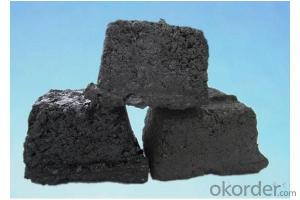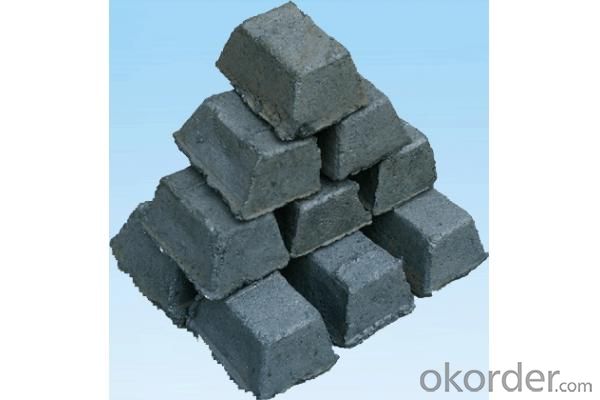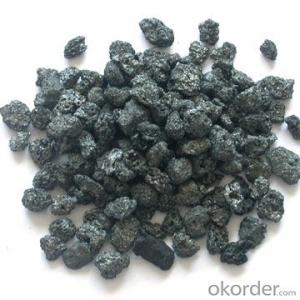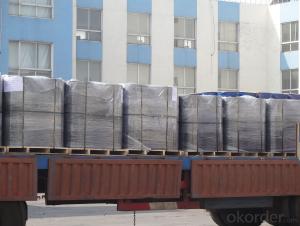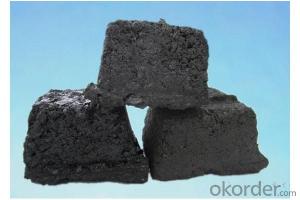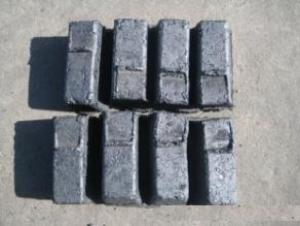Low Ash Carbon Electrode Paste Block Good Delivery Time
- Loading Port:
- Tianjin
- Payment Terms:
- TT OR LC
- Min Order Qty:
- 0 m.t.
- Supply Capability:
- 30000 m.t./month
OKorder Service Pledge
OKorder Financial Service
You Might Also Like
Spcifications
1:carbon eletrode paste
2:for ferroalloy,calcium carbide manufacture
3:HS 3801300000,YB/T5212-1996,ISO9001:2008
Product Description
Carbon Electrode Paste is a self-baking electrode used in submerged arc furnaces for delivering power to the charge mix. Electrode Paste is added to the top of the electrode column in either cylindrical or briquette form. As the paste moves down the electrode column the temperature increase causes the paste to melt and subsequently bake forming a block of electrically conductive carbon. Electrode Paste is essentially a mix of Electrically Calcined Anthracite (ECA) or Calcined Petroleum Coke (CPC) with Coal Tar Pitch.
Graphite/Carbon Electrode Paste
Specification/Item |
|
|
|
|
|
|
Ash | 4.0%max | 5.0%max | 6.0%max | 7.0% Max | 9.0% Max | 11.0% Max |
VM | 12.0%-15.5% | 12.0%-15.5% | 12.0%-15.5% | 9.5.0%-13.5% | 11.5%-15.5% | 11.5%-15.5% |
Compress Strength | 18.0Mpa Min | 17.0Mpa Min | 15.7Mpa Min | 19.6Mpa Min | 19.6Mpa Min | 19.6Mpa Min |
Specific Resistance | 65μΩm Max | 68μΩm Max | 75μΩm Max | 80μΩm Max | 90μΩm Max | 90μΩm Max |
Bulk Density | 1.38G/CM3 Min | 1.38G/CM3 Min | 1.38G/CM3 Min | 1.38G/CM3 Min | 1.38G/CM3 Min | 1.38G/CM3 Min |
Spcifications
1:carbon eletrode paste
2:for ferroalloy,calcium carbide manufacture
3:HS 3801300000,YB/T5212-1996,ISO9001:2008
Pictures
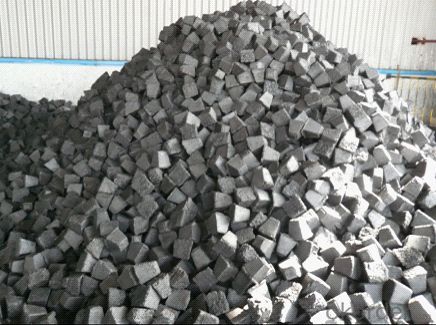
- Q: What are the advantages and disadvantages of carbon monoxide and carbon dioxide?
- Using carbon dioxide instead of traditional organic solvents to spray paint can effectively reduce the amount of harmful substances released into the atmosphere during the process of spraying. In the high-tech, carbon dioxide has its use for laser treatment using carbon dioxide instead of helium neon, can reduce the pain of patients, and save the cost for carbon dioxide extraction of egg yolk lecithin, considerable economic benefit. Carbon dioxide can be used to wash clothes, and does not pollute the environment, but also a wide range of sources. These are all benefits. The downside is the increased carbon dioxide caused by the greenhouse effect, resulting in the polar melting glaciers, rising sea levels, threatening the coastal city, the land salinization of coastal areas, increasing the difficulty of development, increasing temperature also makes the melting of snow in some of the top of the hill, the snow melt water resources of river water to reduce or even stop the phenomenon to occur, the affected area production activities. The increase of the atmospheric temperature, resulting in carbon dioxide absorption in some marine algae wantonly breeding, resulting in the death of algae absorb carbon dioxide, indirectly affect the fishery breeding, and the carbon dioxide in the atmosphere increases toward the vicious spiral. Take | enthusiastic users on 2013-11-09 12:52
- Q: What's the reason for grading? What about the use of composites? What's the difference?
- 2, according to mechanical properties can be divided into general type and high performance type. The strength of the universal carbon fiber is 1000 MPa (MPa) and the modulus is about 100GPa. High performance carbon fiber is divided into high strength (strength 2000MPa, modulus 250GPa) and high model (modulus 300GPa or more). Strength is greater than 4000MPa, also known as ultra high strength; modulus is greater than 450GPa, known as ultra-high model. With the development of aerospace and aviation industry, carbon fiber with high strength and high elongation has come into being. Its elongation is greater than 2%. The largest amount of polyacrylonitrile is PAN based carbon fiber.
- Q: What is the density of carbon?
- The density of carbon is approximately 2.26 grams per cubic centimeter.
- Q: What is carbon fixation in biology?
- Carbon fixation in biology refers to the process by which carbon dioxide (CO2) from the atmosphere is converted into organic compounds by living organisms. It is a crucial step in the global carbon cycle and is primarily carried out by autotrophic organisms, such as plants, algae, and certain bacteria. During carbon fixation, the enzyme RuBisCO (ribulose-1,5-bisphosphate carboxylase/oxygenase) catalyzes the reaction between CO2 and a five-carbon sugar molecule called ribulose bisphosphate (RuBP). This reaction produces two molecules of a three-carbon compound called 3-phosphoglycerate (3-PGA). This initial step is known as the Calvin cycle or C3 photosynthesis. In plants, the 3-PGA molecules are then converted into other organic compounds, such as sugars, starches, and cellulose, through a series of enzymatic reactions. These organic compounds serve as building blocks for the plant's growth and development. Carbon fixation plays a critical role in maintaining a balance of atmospheric CO2 levels and is a key process in regulating climate change. It allows for the transfer of carbon from the atmosphere into the biosphere, ultimately reducing the concentration of greenhouse gases and mitigating the effects of global warming. Moreover, carbon fixation is essential for sustaining life on Earth as it provides the basis for food chains and supports the growth of other organisms. Heterotrophs, including animals and humans, depend on the organic compounds produced by autotrophs through carbon fixation for their energy and nutritional needs. Overall, carbon fixation is a fundamental process in biology that enables the conversion of atmospheric carbon dioxide into organic compounds, sustaining life and helping to regulate the Earth's climate.
- Q: Where do I buy DNF premium advanced carbon?
- Seems to be in the mall in the wish gift box, oh, do not remember, I do not know, is not it?! Look, I haven't played that game for a long time. I hope I can help you
- Q: How does carbon affect the formation of tsunamis?
- Carbon does not directly affect the formation of tsunamis. Tsunamis are primarily caused by underwater earthquakes, volcanic eruptions, or landslides. Carbon, in the form of carbon dioxide (CO2), is a greenhouse gas that contributes to global warming and climate change. While carbon emissions and the resulting climate change can impact ocean temperatures and sea levels, they do not directly trigger the formation of tsunamis. However, it is important to note that climate change can indirectly influence the intensity and frequency of natural disasters, including tsunamis, through its impact on oceanic and atmospheric conditions. Rising sea levels caused by melting glaciers and polar ice can potentially increase the destructive power of tsunamis by allowing them to reach further inland. Additionally, climate change can affect the frequency and magnitude of earthquakes and volcanic activity, which are the primary triggers of tsunamis. Therefore, while carbon emissions do not directly affect tsunami formation, their impact on climate change can indirectly influence the factors that contribute to the occurrence and severity of tsunamis.
- Q: What is the symbol for carbon?
- "C" is the symbol representing carbon.
- Q: But their chemical symbols are different, so they are different elements, different substances, but they feel the same thing... Tangled up ~!
- No one is the same. Lead is poisonous, and pencil lead is lead. The structure of carbon is the same as that of diamonds. Generally speaking, they are of structure, density and composition. No one is the same
- Q: How does carbon affect the quality of soil?
- Carbon plays a crucial role in determining the quality of soil. When organic matter, such as dead plants and animals, decomposes, it releases carbon into the soil. This process is known as carbon sequestration, and it is essential for maintaining soil fertility and health. The presence of carbon in soil promotes the growth of beneficial microorganisms, such as bacteria and fungi, which contribute to the breakdown of organic matter and the recycling of nutrients. These microorganisms help to create a rich and fertile soil environment, ensuring that essential nutrients are available for plants to absorb. Additionally, carbon in soil improves its structure and water-holding capacity. It acts as a sponge, allowing the soil to retain moisture, which is crucial for plant growth and survival. Carbon also helps to prevent soil erosion by binding particles together, reducing the risk of nutrient loss and water runoff. Furthermore, carbon enhances the soil's ability to store and release nutrients. It acts as a reservoir, holding onto essential elements like nitrogen, phosphorus, and potassium, and gradually releasing them to plants over time. This nutrient cycling is vital for sustaining healthy plant growth and productivity. Unfortunately, modern agricultural practices, such as excessive tilling, overuse of synthetic fertilizers, and deforestation, have led to a significant decline in soil carbon levels. This loss of carbon has detrimental effects on soil quality, leading to decreased fertility, increased erosion, and reduced water-holding capacity. To mitigate these negative impacts, it is crucial to adopt sustainable agricultural practices that focus on carbon sequestration and soil conservation. These practices include reducing tillage, incorporating cover crops, practicing crop rotation, and applying organic fertilizers. By increasing carbon levels in soil, we can improve its quality, promote plant growth, and ensure the long-term sustainability of our agricultural systems.
- Q: What should I do when carbon monoxide leaks?
- Of course, in saving at the same time, to find out the cause of the gas leak as soon as possible, and to other people and then plugging, lest suffer. PoisoningTo avoid leakage and gas poisoning accident occurred in the home, can install household gas alarm detector | gas leak alarm, it can predict in advance the gas leak alarm, prompting the user, open the window as soon as possible to prevent accidents.
Send your message to us
Low Ash Carbon Electrode Paste Block Good Delivery Time
- Loading Port:
- Tianjin
- Payment Terms:
- TT OR LC
- Min Order Qty:
- 0 m.t.
- Supply Capability:
- 30000 m.t./month
OKorder Service Pledge
OKorder Financial Service
Similar products
Hot products
Hot Searches
Related keywords
